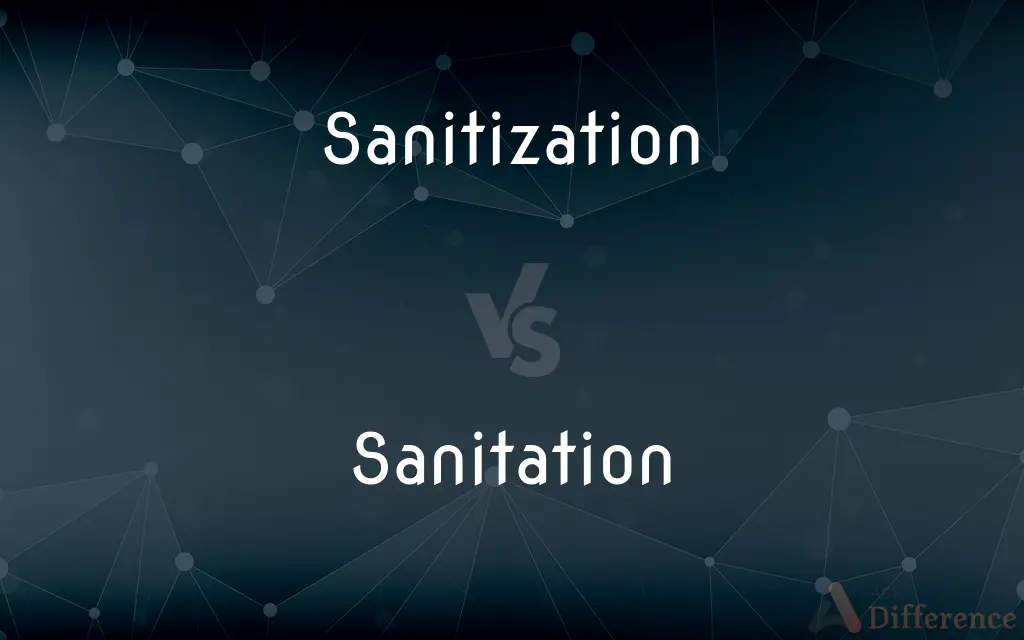Sanitization vs. Sanitation — What's the Difference?
By Fiza Rafique & Urooj Arif — Updated on April 4, 2024
Sanitization involves reducing the number of bacteria to safe levels, while sanitation refers to maintaining clean conditions to prevent disease.

Difference Between Sanitization and Sanitation
Table of Contents
ADVERTISEMENT
Key Differences
Sanitization is the process of cleaning and disinfecting surfaces or objects to reduce the presence of bacteria, viruses, and fungi to levels considered safe by public health standards. It's often used in contexts like food preparation, healthcare, and childcare, where controlling the microbial population is crucial to prevent infections. Sanitation, on the other hand, encompasses a broader range of practices aimed at promoting hygiene and cleanliness, including the safe disposal of waste, provision of clean drinking water, and adequate sewage treatment, to prevent the spread of diseases.
While sanitization focuses on microbial reduction on surfaces or objects to safe levels, sanitation aims at creating an environment that supports overall health through cleanliness and hygiene practices. For instance, sanitization would be a key component in a restaurant's kitchen to ensure that food contact surfaces are free from harmful microbes, whereas sanitation would involve the entire spectrum of practices to ensure food safety, including waste disposal and pest control.
Sanitization methods include the use of chemical disinfectants, heat, or ultraviolet light to kill or deactivate pathogens. In contrast, sanitation practices might involve infrastructure development, such as constructing sewer systems, as well as behavioral practices like handwashing.
Public health policies often require both sanitization and sanitation measures to protect communities from health risks associated with unsanitary conditions and infectious diseases. For example, during a viral outbreak, sanitization of surfaces people frequently touch, combined with broader sanitation efforts like ensuring access to clean water and proper waste management, are key strategies in controlling the spread of the disease.
Both sanitization and sanitation are crucial for maintaining public health, but they operate at different scales and scopes. Sanitization is a component of broader sanitation efforts, which encompass a wide range of environmental and personal hygiene practices designed to sustain a healthy living environment.
ADVERTISEMENT
Comparison Chart
Definition
Reducing microbes on surfaces or objects to safe levels.
Maintaining conditions to prevent disease through cleanliness.
Focus
Microbial reduction to prevent infection.
Overall environmental hygiene and health.
Methods
Chemical disinfectants, heat, UV light.
Waste disposal, clean water supply, sewage treatment.
Application
Food surfaces, medical instruments, childcare items.
Infrastructure, public facilities, residential areas.
Objective
Ensure surfaces or objects are free from harmful pathogens.
Create a hygienic environment to prevent disease spread.
Compare with Definitions
Sanitization
The process of cleaning and disinfecting to reduce bacteria, viruses, and fungi to safe levels.
After preparing chicken, sanitization of the kitchen counters is necessary to prevent salmonella.
Sanitation
Involves public education and behavior change towards hygiene practices.
School sanitation programs teach students the importance of handwashing to prevent illness.
Sanitization
Often involves chemicals or heat to disinfect surfaces and objects.
The hospital uses a steam sterilization method for sanitization of surgical tools.
Sanitation
The practice of maintaining clean conditions to prevent disease and promote health.
Improved sanitation facilities have decreased the incidence of cholera in the community.
Sanitization
Primarily in healthcare, food preparation, and childcare settings.
Regular sanitization of toys in childcare centers helps prevent the spread of colds and flu.
Sanitation
Requires investment in facilities like sewage treatment plants and clean water systems.
The government allocated funds for upgrading the sanitation infrastructure, ensuring clean water access.
Sanitization
Reduces the risk of infection and disease transmission in targeted environments.
Proper sanitization of gym equipment reduces the transmission of skin infections.
Sanitation
Includes waste management, water purification, and personal hygiene education.
The city's new sanitation program focuses on recycling and composting to reduce landfill waste.
Sanitization
Follows public health guidelines to determine safe levels of microorganisms.
The restaurant's kitchen must meet health department sanitization standards to operate.
Sanitation
Essential for public health, particularly in urban areas and developing countries.
Access to sanitation in rural areas remains a challenge, affecting children's health and education.
Sanitization
To make sanitary, as by cleaning or disinfecting.
Sanitation
Sanitation refers to public health conditions related to clean drinking water and adequate treatment and disposal of human excreta and sewage. Preventing human contact with feces is part of sanitation, as is hand washing with soap.
Sanitization
To make more acceptable by removing unpleasant or offensive features from
Sanitized the language in adapting the novel for television.
Sanitation
Conditions relating to public health, especially the provision of clean drinking water and adequate sewage disposal
They could afford to erect new dwellings with a reasonable standard of construction and sanitation
Sanitization
The act of sanitizing something.
Sanitation
The study and application of procedures and measures designed to protect public health, as in the provision of clean water and the disposal of sewage and waste.
Sanitization
The process of editing a security-classified document in order to reduce its classification level.
Sanitation
The disposal of sewage and waste.
Sanitization
Making something sanitary (free of germs) as by sterilizing
Sanitation
The hygienic disposal or recycling of waste.
Sanitation
The policy and practice of protecting health through hygienic measures.
Sanitation
The act of rendering sanitary; the science of sanitary conditions; the preservation of health; the use of sanitary measures; hygiene.
How much sanitation has advanced during the last half century.
Sanitation
The state of being clean and conducive to health
Sanitation
Making something sanitary (free of germs) as by sterilizing
Common Curiosities
Can sanitization methods vary?
Yes, sanitization methods can vary, including chemical disinfectants, heat treatment, and UV light, depending on the setting and objects being sanitized.
How does sanitation affect public health?
Effective sanitation prevents the spread of diseases, improves quality of life, and supports sustainable development by managing waste and ensuring clean water.
How do sanitization and sanitation work together?
Sanitization processes reduce pathogens in specific environments, while sanitation practices provide a broader approach to public health, including waste and water management, both crucial for disease prevention.
What is a common challenge in sanitation?
A common challenge in sanitation is providing adequate facilities and infrastructure, especially in rapidly growing urban areas and resource-limited settings.
Why is sanitization important in food service?
Sanitization is crucial in food service to prevent foodborne illnesses by reducing pathogens on surfaces and equipment.
Can natural products be used for sanitization?
Some natural products, like vinegar and certain essential oils, have antimicrobial properties, but may not be sufficient for all sanitization needs according to public health standards.
What is the difference between sanitization and sterilization?
Sanitization reduces germs to a safe level, while sterilization kills all forms of microbial life, including spores, and is required for surgical instruments.
What products are effective for sanitization?
Products containing bleach, alcohol (at least 70%), and other EPA-approved disinfectants are effective for sanitization.
How often should sanitization occur in a healthcare setting?
Sanitization in healthcare settings should occur regularly, after each patient visit for certain equipment, and at least daily for high-touch surfaces.
What is the global impact of inadequate sanitation?
Inadequate sanitation affects over 2 billion people worldwide, leading to serious health, environmental, and socio-economic issues.
What are the economic benefits of investing in sanitation?
Investing in sanitation leads to lower healthcare costs, improved productivity, and economic growth by preventing disease and preserving the environment.
What are the social implications of poor sanitation?
Poor sanitation can lead to stigma, social exclusion, and diminished educational opportunities, particularly affecting women and girls, and contributing to inequality.
How does improper sanitization affect food safety?
Improper sanitization can lead to cross-contamination, allowing pathogens to spread and increase the risk of foodborne illnesses.
How can individuals contribute to improved sanitization and sanitation?
Individuals can contribute by practicing good hygiene, responsibly disposing of waste, using water efficiently, and supporting community sanitation initiatives.
How do climate change and sanitation intersect?
Climate change exacerbates sanitation challenges through increased flooding and water scarcity, affecting the availability and quality of water for hygiene and complicating waste management.
Share Your Discovery

Previous Comparison
Adjacent vs. Opposite
Next Comparison
Only vs. SolelyAuthor Spotlight
Written by
Fiza RafiqueFiza Rafique is a skilled content writer at AskDifference.com, where she meticulously refines and enhances written pieces. Drawing from her vast editorial expertise, Fiza ensures clarity, accuracy, and precision in every article. Passionate about language, she continually seeks to elevate the quality of content for readers worldwide.
Co-written by
Urooj ArifUrooj is a skilled content writer at Ask Difference, known for her exceptional ability to simplify complex topics into engaging and informative content. With a passion for research and a flair for clear, concise writing, she consistently delivers articles that resonate with our diverse audience.















































